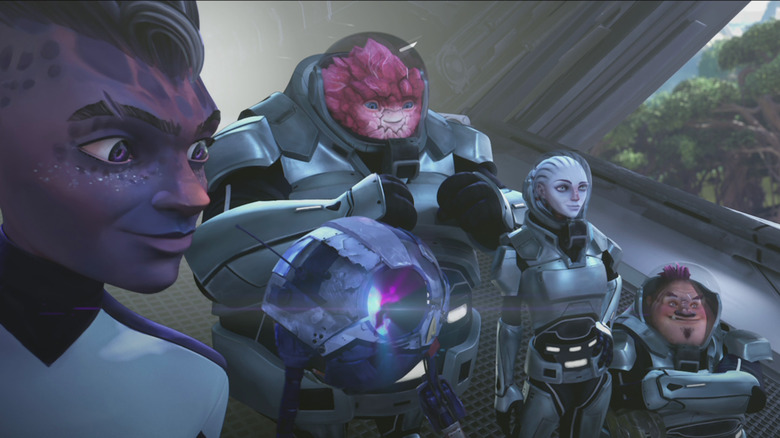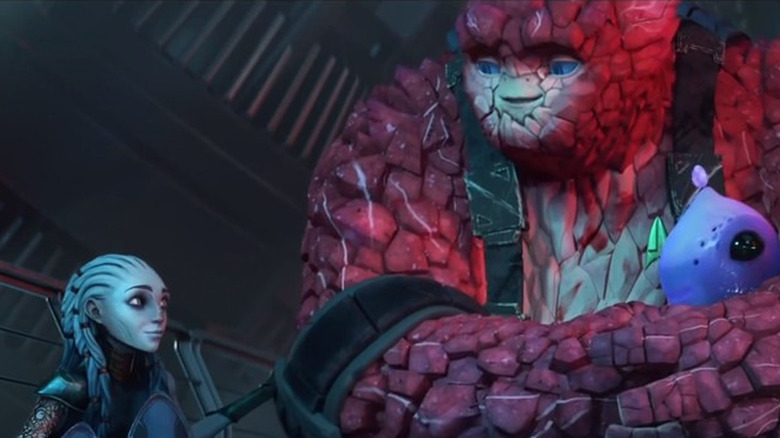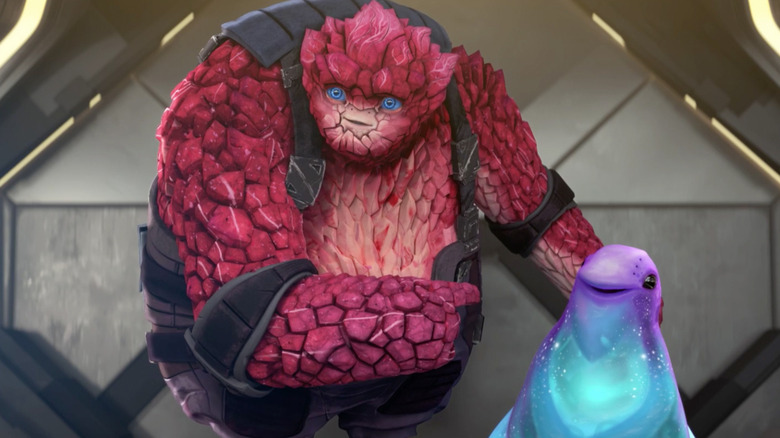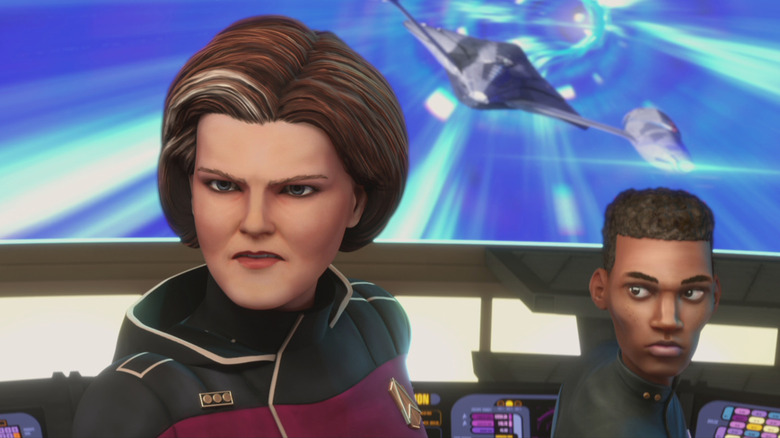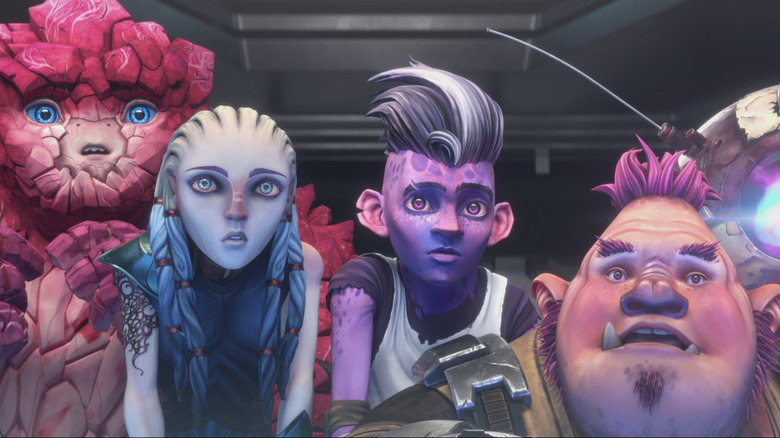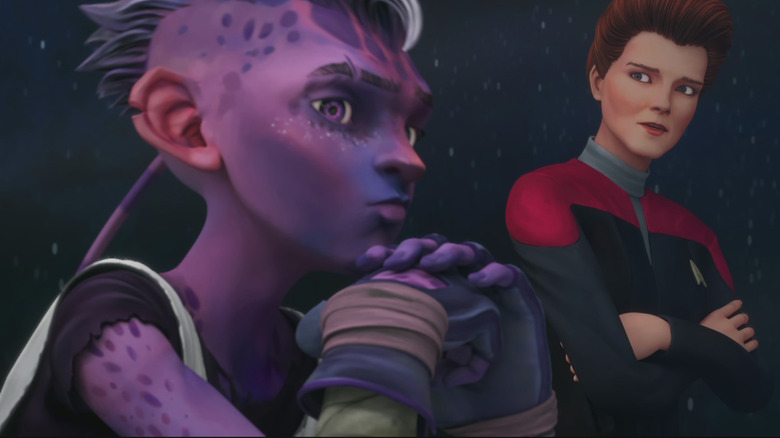Star Trek: Prodigy Creators On Making Trek Accessible For A New Generation [Exclusive Interview]
"Star Trek: Prodigy," which just wrapped its first season on Paramount+, takes place in a distant corner of the "Stat Trek" universe that hasn't yet been explored by the Federation. A group of teenagers, fleeing the man who has enslaved them in a mine, discover a derelict Starfleet vessel called the U.S.S. Protostar. On board, they are instructed by a hologram of Capt. Janeway (Kate Mulgrew) on how to operate the ship, but also how to work together as a Starfleet crew might. The teens have to work through their anxieties and inexperience, but find that they do work well as a team. Their goal is to return to Federation space, while solving the mystery of their abandoned vessel.
"Prodigy" is set about five years after the events of "Star Trek: Voyager," and it is the third animated series in the vast "Trek" franchise. It's also the first show that has been explicitly stated as being for a younger audience, and it is being released under the banner of Paramount's Nickelodeon brand.
The show was created by Kevin and Dan Hageman, who previously worked as screenwriters and executive producers on the "Ninjago" TV series, and have written various feature films like "Scary Stories to Tell in the Dark," "The Croods: A New Age," and "Trollhunters: Rise of the Titans."
The Hagemans recently sat down with /Film to talk about the fineries of "Prodigy," what they did to make it more kid-friendly, and some of the "Star Trek" characters they were considering before they settled on Hologram Janeway.
This interview has been lightly edited for clarity and brevity.
'Do I want to jump into a 'Star Trek' convention and feel lost?'
"Prodigy" is being sold as a kid-friendly version of "Star Trek." But much of "Star Trek" is already appropriate for kids, and I know many who watched it growing up. What was your personal mandate for "Prodigy" to make it more kid-friendly?
Kevin Hageman: There's "The Naked Now." There was a lot of sexualized nature in the history of "Star Trek," I think starting from the Roddenberry days. It's not so much of kid-friendly as in terms of safe, but it's more about ... Trek is massive. The canon is so thick. And it's intimidating, not just for a younger person, but for someone who is interested in "Star Trek" and feel like, "Do I want to jump into a 'Star Trek' convention and feel lost?" This is a show that simplifies things, but it doesn't dumb things down. It's a show that allows viewers to dip their toe to "Star Trek."
Dan Hageman: No, we hold their hand. We're holding their hand, and we're bringing them in gently.
Kevin Hageman: Whether they want to go to "TOS," which we love, or if they want to go to "Voyager," because they love Janeway.
"Prodigy" is unique in that it takes place largely outside the purview of Starfleet. How would you define the "Star Trek" universe as it exists outside of the Starfleet ideals? Because it's actually pretty ill-defined throughout "Trek" up until this point.
Kevin Hageman: Yeah. Again, we wanted to start outside Federation space. And to us, felt like this is a lawless ... this is Charles Dickens in space. I think we had that on our pilot script page. These are mines where they're working children. Why are they working children? Little, tiny mysteries, where we love this idea of, the first piece of "Star Trek" that these kids receive is the Protostar. And on the Protostar, Hologram Janeway. What better way to teach these children the hard knocks of life and how to improve themselves?
'I'd say it's like Flash Gordon'
Kevin Hageman: We talked about early on, we're like, "Well, would it be Picard?" I'm like, "Picard would be a horrible mentor. Picard would hate these children." He would eject them very quickly. Would it be Wesley Crusher? We're like, "No, that feels a little bit off. He's the prodigy, but not quite the guide." And very quickly, we got to the greatness of Janeway. That she could deliver a lesson. Because we figure, these kids are going to be messing up quite a bit because they don't know what they're doing. And I'm like, "Who do I want to hear my lessons from?" And I feel like there's nobody better at delivering a message than Janeway.
Dan Hageman: And I think you'll see, at the end of Episode 10 ["A Moral Star"] we introduce Admiral Janeway [and] Starfleet. And Starfleet is going to be an antagonist now. They're going to be hunting them down. You'll see in the next ten [episodes], them slowly getting more and more closer to Federation space. We get to start introducing these things. So we're not throwing so much at you. We're like, "Oh, there's the Romulans and Vulcans." And I'm like, "No, let's take our time." Let's just introduce these elements, these civilizations, one at a time.
You're dealing with "Star Trek," but you're coming in from the outside. Did you allow yourself to indulge in certain familiarities, or did you want to stay away from really familiar stuff and not make it too "Star Trek" right away?
Kevin Hageman: Yeah, we actively did not want to make it too ... we wanted that moment, when they first get into the ship, for it to feel like "Star Trek." The sounds, the feel. Again, I know we've had a lot of people who, when they first watch it, they go, "Oh, this looks like 'Star Wars.'" And it's a fair assessment. But if you have a walking droid in mines ...
Dan Hageman: I'd say it's like Flash Gordon. Flash Gordon.
'Dilithium's been overused'
The character of Rok-Tahk might be the first instance of taking something that was previously in that nebulous canon of "Star Trek" novels and making it canon. How familiar were you with a lot of that non-canonical or semi-canonical "Star Trek" from Peter David and all of the novel writers?
Kevin Hageman: Yeah. Well, we had a wonderful "Star Trek" advisor. Because it's very scary, starting a new "Star Trek" show. We had David Mack, who is a fantastic "Star Trek" novelist. And so, he would read all of our scripts and would help us out, saying, "No, you can't do that," or, "You can do that." And we fell in love with this idea of this young child, or this big brute at first, because they can't communicate in the pilot ... to discover, it's actually a child. And how it's this character where everyone is going to assume, "Well, they're going to be the security officer." But, no! It's this young kid who loves science, and math, and doesn't want to do that. And so, we started talking about that with David Mack, and David Mack brought up the idea of the Brikars, and then that was a great –
Dan Hageman: David was great. Because we would usually come — we're like, "We want them mining for something, but we don't want it to be dilithium." Dilithium's been overused. And then he'd come back, he's like, "There's this thing called chimerium." I think it was actually from one of his books. We're like, "Okay. What's chimerium?" He's like, "It's what they used to make the –"
Kevin Hageman: Cloaking.
Dan Hageman: The cloak, the cloaking devices. We're like, "Ooh, that's cool. That seems like an illegal operation," of something a villain could sell for quite a bit on the black market. So that was how we came up with chimerium.
'How do we meet in the middle?'
Kevin Hageman: Because it's animation, we can push it. And we can push these characters and these designs. And so, we didn't want to start with the classic bridge crew. We wanted to push the species, and to choose a Medusan. How do we make a Medusan a really cool character?
Dan Hageman: Well, from the animated series, seeing the Caitian. We wanted to put a Caitian in there, little things. In some of the new episodes coming out, people are realizing on Chakotay's crew there ... Aurelian? This bird ... Was that from the animated series?
Kevin Hageman: Yeah, from the animated series.
Dan Hageman: But it was fun to take these things and reimagine them. What would they look like in this look and feel?
Did you rely mostly on David Mack, or did you know a great deal about "Star Trek" going in?
Kevin Hageman: We had a good, fair assessment. We grew up on a lot of the movies, in particular, but we also surrounded ourselves with people like Aaron Waltke and the Benson sisters. Our writing staff, we had some new people who are new to "Star Trek," and then we had a lot of huge, existing fans who had watched every series from day one.
Dan Hageman: But it was good having those conversations of, here's the super-fan perspective, and here's the person who's never seen "Star Trek's" perspective. How do we meet in the middle? Something that's digestible, that doesn't take us on a five-minute exposition ramp.
Kevin Hageman: And to be able to take those Easter eggs, those legacy characters or species that might have not been used that much, but then also to create the Vau N'Akat, and to create our own alien race. And we're doing new things.
'You can't have two captains of a ship'
Dan Hageman: There's times, if you're introducing the Borg, and we have, at most, 30 seconds to one minute to have Janeway explain what the Borg are. What do you say? What do they need to know?
You mentioned that there were certain things you tried to do that you said that you couldn't do, and David Mack said, "That's not appropriate." Could you tell me what some of those things are?
Dan Hageman: I want to share something. When we were looking at our pilot episode, and when we were looking at designing the ship, we were talking about, "Oh, wouldn't it be fun to have Gwynn and Dal sitting in two chairs captaining the ship together?" And David Mack is like, "No. No, no. You can't have two captains." Imagine a battleship –
Kevin Hageman: You can't have two captains of a ship.
Dan Hageman: Yeah, it doesn't work that way.
Kevin Hageman: In wartime, that would be the worst thing.
Dan Hageman: We were like, "You're right. You're right. There's going to be one seat in the center of this ship. Stuff like that. Like, "Oh yeah, of course."
"Star Trek: Prodigy: Season 1 Volume 1" is now available on Blu-ray and DVD.
